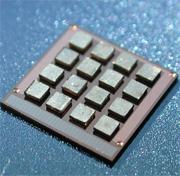 An array of tin stuck to a thermometer does a good job of telling radioactive materials apart.Credit: NIST
An array of tin stuck to a thermometer does a good job of telling radioactive materials apart.Credit: NISTIt's a hard life being a US border patrol agent. Hundreds of thousands of vehicles enter the United States every single day. The Department of Homeland Security is in the process of installing some 2,400 radiation monitors at crossings to spot clandestine nuclear material. But the system is overloaded with false alarms.
The biggest problem is kitty litter. The clay in cat litter gives off enough gamma-rays (γ-rays) to trigger a detector. And the high-purity germanium (HPG) detectors used at the borders often confuse it with highly enriched uranium.
This is because the HPG detectors are very sensitive, but not very discriminatory. The clay makes a spike in the energy spectrum very similar to that produced by highly enriched uranium, and the detector usually can't tell them apart. What the patrols need is a detector with better resolution, enabling it to distinguish cat litter from weapons material.
Zink's tin
Barry Zink and colleagues at the National Institute of Standards and Technology (NIST) in Boulder, Colorado, along with their Los Alamos collaborators, are working towards just such a sensor. At the American Physical Society meeting on 14 March, they reported that their sensor had a resolution ten times better than the best conventional γ-ray detectors.
The NIST sensor is essentially a piece of tin glued to a thermometer. When γ-rays hit the tin they raise its temperature by an amount that corresponds to their energy.
The thermometer consists of a bilayer of superconducting material held at 100 thousandths of a degree above absolute zero. When it is this chilly, the material's electrical resistance changes with temperature, making it a very sensitive thermometer.
Zink admits that the incredibly low temperature is "somewhat challenging" to achieve, but points out that cryogenic refrigerators have vastly improved in the past decade. Some are even small enough to fit on a golf cart, says Zink.
Acid test
To put their sensor through its paces, Zink and his co-workers drove 650 kilometres to a division of the National Nuclear Security Administration at Los Alamos. The sensor successfully detected plutonium-239 — a key ingredient in nuclear weapons — even in the presence of other radioactive materials with a similar signal. This proved the detector's ability to distinguish one peak from another. Zink next plans to test the detector in the energy range of uranium and cat litter.
But there's a problem. The pieces of tin in the NIST sensor need to be small, because increasing their size adds noise to the measurements. This means the sensor absorbs much less radiation than the usual HPG detectors — making weak or well-shielded sources hard to detect.
To get around this, Zink and his colleagues built an array of tin absorbers, each 1-mm-square, all glued to the superconducting bilayer. The only remaining challenge is to keep the whole thing cool: the bigger the sensor, the harder this becomes.
Big plans
ADVERTISEMENT
Zink's biggest array so far has 16 squares of tin, but he and his team are planning to build one with 100. They say they will need at least 100 to 1,000 sensors to equal the performance of the HPG detectors.
Such arrays will never be big enough for border controls to screen trucks at a distance. But they could be used at close-quarters to investigate alarms raised by other detectors.
And maybe one day, consignments of cat litter will cross borders unmolested.
Visit our kittylitteranduranium_i.html">newsblog to read and post comments about this story.
